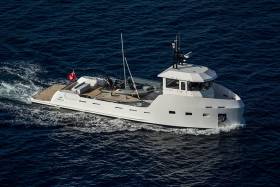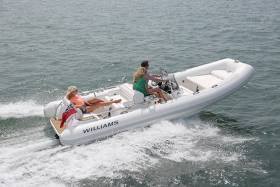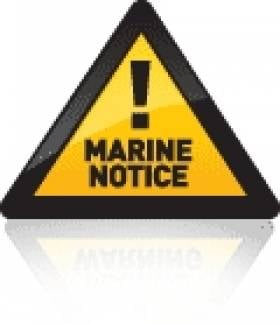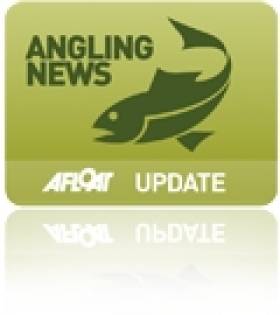Displaying items by tag: tender
2024 State Fisheries Tender Process Now Open
The tender process for Inland Fisheries Ireland’s (IFI) State fisheries for 2024 is now open.
State-owned fishing rights are made available for licence to interested angling clubs every year and IFI generally has licence agreements with over 50 fishing clubs, allowing them to fish on more than 90 fisheries where the rights are State-owned.
If your club wants to tender for one or more fisheries, you can apply online. Alternatively, download and fill out the Condition of Tender Questionnaire and return it to IFI by post; please mark your envelope TENDER APPLICATION and send it to: Paul O’Reilly, Business Development, Inland Fisheries Ireland, 3044 Lake Drive, Citywest, Dublin 24.
If your club is interested in a longer-term licence, please fill out the relevant section on your form and we will be in touch with you. Please tender the ‘per year’ licence fee.
Please also complete the End of Year Report in respect of each fishery held under licence last season if you have not already done so.
Tenders will be accepted up until Friday 19 January 2024; proof of postage on or before this date will be accepted.
If you have any queries relating to State Fisheries or the 2024 tender process, get in touch with Paul O’Reilly at [email protected].
The Department of Agriculture, Food and the Marine invites suitably qualified contractors to submit a tender package to construct up to two reinforced concrete boatyard repair bays within the existing DAFM Boatyard located on the West Pier of Howth Fishery Harbour Centre.
The repair bays will be around 500 sqm each, with works to include surfacing, installation of draining pipework, gullies and manholes (of a depth not greater than 2m) and more.
The successful contractor will also be expected to excavate and dispose of existing life-expired asphalt surfacing off-site at a licensed facility.
This tender award is expected in late May or early June with works to commence in June or July, and is awarded subject to available funding.
The RFT is in one lot and can be viewed on the eTenders website under reference 210774. The deadline for responses to this tender is noon on Wednesday 4 May.
Upgrade Works on Howth Harbour’s Arsenal Building Open for Tender
The Department of Agriculture, Food and the Marine is inviting tenders from suitably qualified contractors to carry out various upgrade works on the Arsenal Building on Howth Harbour’s West Pier.
The building currently serves as the fishermen’s toilet and shower unit at Howth Fishery Harbour Centre in north Co Dublin.
Works required include roofing, stonework cleaning and pointing as well as general repairs and upgrades such as installing new doors and windows.
Tenders are to be submitted in one lot. The request for tender (RFT) is in a single lots and can be viewed on the eTenders website under reference 196560.
YXT 20m Support Vessel World Debut At Monaco Yacht Show
The YXT 20 was conceived to support power and sailing yachts of any size, or be an explorer yacht, all on her own.
The large 45 square meter open deck can be a comfortable base for a large tender, a sailboat, 2 wave runners, a big RIB, paddle boards, wind surf boards, Sea Bobs, scuba diving gear, submarines, containers, cars or motorcycles and literally tons of storage.
The YXT 20's interiors design is by Franck Darnet of Franck Darnet Design. The yacht was conceived as a support vessel for superyachts ranging from 30 to over 70 meters. The unit is propelled by two 715hp Cummins diesels giving her a range of 900 nautical miles and a 14 knot cruising speed.
YXT 20 support vessel has a white livery, giving her a fresher and more marine aspect. This color scheme also emphasizes the gamma's production philosophy: created for carrying extra toys and gadgets, the vessel's use is closer to the fun and leisure aspects of seagoing (beach club or party deck, even extra accommodation).
A stern mounted gangway davit, allowing use of the transom beach area to carry tenders and jet skis. The stairs and the first four meters of deck are completed in teak, underlining the yachting style of the YXT 20.
LAYOUT
The YXT 20’s design recognizes that different owners have different objectives, so is available in two versions – “High Profile” with extra freeboard and “Low Profile”.
In the High Profile version, the YXT 20 can accommodate eight with four guest in two luxurious guest cabins. In both versions, four crew enjoy comfortable and efficient crew quarters in two twin cabins with galley, stowage and laundry plus one large storage container accessible from
the main deck. It can also be used for extra refrigerator appliances, wine cellars, or when necessary, even an extra accommodation, a spa or a gym. Like any LYNX yacht, owners can customize and make it their own.
DAVITS AND SUPPORT EQUIPMENT
This is the primary characteristic of every support vessel. The YXT 20 features two davits - the primary is located on the main deck, the secondary, which also serves as the gangway, at the stern. The two 360-degree davits have a lifting capacity of 1.7 tons primary, 0.5 at the stern with a 5 meter reach and 360° slewing.
INTERIORS
Guest area and lounge: bulkheads and overheads in natural wood veneer marine grade plywood, parquet flooring. Furnishings in natural wood veneer marine grade plywood.
CREW QUARTERS
Bulkheads in natural wood veneer marine grade plywood, parquet flooring. Furnishings in white laminate veneer marine grade plywood with wood trim.
YXT 20 STORAGE DIMENSIONS AND VOLUME
Hold: 5m x 5m, 25m2
Available volume: apx. 30m3 of stowage with standing headroom Length: 5m
Width at deck level: apx. 5.5m
Centerline headroom: 1.8m/1.95m
Lateral headroom (for storage only): 1.25m
Available storage volume: 30cbm
Williams Jets Tenders Invests In Boat Builders of the Future
Oxfordshire-based Williams Performance Tenders in the UK is has announced it will once again be giving local students the chance to take part in its innovative training scheme. Now in its fourth year, the course offers young people a fantastic chance to gain valuable practical experience in the marine industry, as well as have the opportunity to become an apprentice with the global-leading brand.
10 young people from schools in Oxfordshire have been selected to attend the five-week Powerboat Workshop course. The practical sessions, which kick off on 23rd April are designed to give young people the chance to learn life-long skills that can be used in future employment, and to teach them more about the sector where Williams Jet Tenders is recognised as a global leader.
The sessions will culminate in an exciting race day at Williams’ test lake on 21st May. Last year, 10 young people enjoyed a fantastic day racing model speed boats of their own designs on the water, and were also given the opportunity to go for a spin as a passenger in one of Williams’ sporty jet tenders.
One attendee from last year’s event was John Howell, MP for Henley who really enjoyed the event and recognised the value the course can bring to young people in Oxfordshire, commenting: “I was so impressed with last year’s event and what the young people had achieved. This really is a fantastic initiative that Mathew and John have set up that is really giving young people a great chance of a career, as well as investing in the future of the industry. I am looking forward to seeing what the students achieve this year and to another thrilling end of course race.”
As in previous years, one of the participants from the course will also be given the opportunity to start work as an apprentice at Williams – underpinning the brand’s commitment to investing in the boat builders of tomorrow. Two young apprentices are already employed at the factory which continues to grow in response to increased global demand.
The scheme was started by brothers Mathew and John Hornsby, founders of Williams Jet Tenders, and is run in partnership with Employment Action Group.
Mathew Hornsby, Sales Director at Williams Performance Tenders, commented: “It’s always been important to John and I that we help to nurture and invest in the boat builders, designers and engineers of our future. We have been so impressed with the calibre of the students, as well as their dedication and hard work over the past three years, and we have high hopes for the young people taking part this year.
“The apprentices that we’ve hired over the past few years are working out really well and it’s fantastic to see them grow in their role here at Williams. Our past students have all really enjoyed the course, particularly the race day at the end, as it gives them a chance to see everything we’ve taught them about designing and building boats in action.”
Founded by brothers Mathew and John Hornsby in 2004, Williams Jet Tenders has established itself as the world’s leading jet tender specialist, renowned for its range of Turbojet, Dieseljet and Sportjet models. The company is launching a new range in 2016, the MiniJet. Williams Jet Tenders now employs 60 staff at its Oxfordshire base, and is supported by a global team of factory trained engineers.
Discounted Inflatable Tender at €450 From O'Sullivan's Marine
O'Sullivan's Marine in Tralee County Kerry has a range of discounted inflatable tenders for sale. The WavEco 2.30M solid transom has an air floor and has a special offer price of €450 down from €525.
The WEC230 AM/3 has a max horsepower of 3hp and a capacity for 3 persons. The packing size is 105cm x 60cm x 32cm and weighs only 31kg. The quality fabric is made from 750gram 1100 Denier polyester and is covered by a three year limited warranty.
See the full line up of boats for sale here.
Passenger Ship Tendering Requirement Details
#tender – The Department of Transport, Tourism and Sport wishes to advise Shipowners, Ship Operators, Shipmasters, Harbour Masters and Ships' agents of the requirements for passenger ships engaged in the tendering of passengers between the ship and shore.
All tender vessels must comply with the relevant provisions of the Merchant Shipping Acts. There are two main types of tendering as follows:
(a) Passenger Ships using ship's own tender vessels;
(b) Shore based domestic tender.
Considering each as follows:
(a) Ship's Own Tender Vessels – International Cruise Ships
It may be necessary for a ship to use its own tenders in cases where suitable berthing facilities are not available, or where the ship's draft or size prevents it from entering a port. This is permissible under the Merchant Shipping Act 2010 which sets out the requirements to be followed.
Proposals must be in compliance with the provisions of the Merchant Shipping Act 2010 and the IMO Guidelines for Passenger Ship Tenders as contained in IMO circular MSC.1/Circ.1417.
• There must be adequate manning on the bridge to ensure that the tendering operation is continuously monitored.
• Tendering operations are not to be carried out in restricted visibility.
• The ship and its tenders must maintain a continuous listening watch on VHF Channel 16 and the port working channel at all times during the operation.
• The ship must have the approval of the port(s) in which any operations are to take place.
(b) Using Shore Based Tender Vessels – Domestic Passenger Ships/Boats
All such tender vessels must comply with the Merchant Shipping Acts and hold a current valid passenger ship safety certificate or passenger boat licence.
Domestic Passenger ships/boats are to be moored to a single point mooring for the duration of the transfer. Such moorings are to be licensed by Coastal Zone Management (Foreshore Unit, Department of the Environment, Community and Local Government), and must not be located such as to cause obstruction to other vessels. Owners must ensure that such moorings are inspected on an annual basis.
Domestic Tendering operations will normally only be permitted for the summer period comprising of June, July and August and is subject to annual review.
Application Procedure
The owner or master of a ship who proposes to undertake a tendering operation at any place in the State, in respect of that ship, must apply to the Marine Survey Office for a permit to undertake such operation by submitting for approval a "Tendering Operations Safety Plan Proposal" in the format laid out in the Annex to this notice. An application for a permit to tender should be submitted 28 days before the date of the proposed tendering, to allow sufficient time for the proposal to be assessed.
The Marine Survey Office may withdraw a permit to carry out tendering operations where there is a failure to comply with the conditions of the permit.
This Marine Notice supersedes Marine Notice No. 12 of 2013.
Irish Maritime Administration,
Department of Transport, Tourism and Sport,
Leeson Lane, Dublin 2, Ireland.
18/02/2014
Encl.: Annex
Annex to Marine Notice No. 19 of 2014
MARINE SURVEY OFFICE
TENDERING OPERATIONS – SAFETY PLAN PROPOSAL
Operators:
Address:
Proposed tendering location:
Period of tendering proposed:
Description of proposed operation:
Insurance company details:
Nominated company official responsible for tendering operation:
Tendering Craft Details:
Type/names of vessels:
Number of tenders:
Is the tender a SOLAS approved Lifeboat as per MSC.1/circ.1417:
Materials of construction:
Number of crew in tender:
Maximum number of passengers in tender:
Propulsions Means / KW:
Number of lifejackets/buoyancy aids available for passengers:
Luggage transported separate to passengers, yes or no:
Tender Safety Certificate attached (last service inspection for Rib/Zodiac type boats)
Passenger Ship Details:
Name of ship(s):
Offshore mooring facilities available (give GPS co-ordinates):
Expected distance from vessel to shore:
Maximum number of passengers:
Means of berthing tender alongside:
Access means to board passenger vessel (ladder, ramp etc):
Means of embarkation from ashore, e.g. Slipway, steps, pontoon etc
Wind conditions:
Maximum wind conditions for tendering operation as per risk assessment for operation
Wave / Swell Height:
Maximum operational swell height for operation
Alternatives due to suspension of tendering:
Alternative proposals for suspension of tendering operations, i.e. Stranded passengers
Disabled passengers:
Disabled / special needs passengers – tendering operation arrangements:
Lifejackets/PFDs
SOLAS lifeboat type tenders – Where lifejackets are not worn but stowed in tender, has a risk assessment been carried out or is an ISM procedure in place?
Emergency Assistance
What emergency assistance is available for a tender in difficulty?
IMO Guidelines (not applicable to certified domestic passenger ship/boats)
Please confirm that the tender vessel and operation comply with the requirements of IMO circular MSC.1/Circ.1417
Safety Announcements:
Safety announcement to passengers:
1. Prior to boarding tender from pier, yes or no:
2. Prior to disembarking tender, yes or no:
3. Prior to embarking tender from passenger vessel, yes or no:
Operational records:
Method of keeping tendering operation records:
To include details of: dates & times of tendering, no. of trips and passenger numbers carried by each tender, name of passenger vessel embarking/disembarking, prevailing weather & sea state conditions
Proposed tendering dates:
Dates Operational times
1.
1.
2.
2.
3.
3.
4.
4.
5.
5.
6.
6.
7.
7.
Additional actions proposed by operations:
When completed, this form should be returned to:
Marine Survey Office, Department of Transport, Tourism and Sport, Leeson Lane, Dublin 2.
IFI Opens State Fisheries Tender Process for 2014
#Angling - The tender process for State fisheries under the auspices of Inland Fisheries Ireland (IFI) for 2014 is now open.
A list of all available fisheries on Ireland's inland waterways is available to download as a PDF file HERE.
Anyone wishing to tender for one or more fisheries should fill out the tender application form (available HERE) and send by post, in an envelope marked TENDER APPLICATION, to:
Justine Barrett,
Business Development,
Inland Fisheries Ireland,
Swords Business Campus,
Swords, Co Dublin
If your angling club is interested in a longer-term licence, please fill out the relevant section on your form and IFi will get in touch. However, please tender the ‘per year’ rate.
Queries relating to State fisheries or the 2014 tender process should be directed to Justine Barrett at [email protected] or 01 884 2600.
Tenders will only be accepted up until 30 November 2013.
In addition, all clubs who held a licence on a State fishery or fisheries during the 2013 season will need to fill out an End of Year Report Form and return it to IFI Swords at the above address by the same date (it may be posted together with a tender application).
End of Year Report Forms have all been sent out to clubs, but a digital version if required is available HERE.
#ISA NEWS - The Irish Sailing Association's Olympic Department is inviting tenders for photographic services and social media content for the Irish sailing team at the Sail for Gold Regatta in Weymouth from 4-9 June.
The tender requires attendance at Sail for Gold from Wednesday 6 to Saturday 9 June inclusive.
The photography portion involves daily coverage of Irish sailors racing with a target of 6-10 images per sailor (schedule to be agreed with support team dependant on campaign performance and availability of media boats), plus headshots of the squad and support teams in team clothing, and group shots with and without support teams.
Social media content will involve daily pre-race audio and video with the performance director; daily audio/video with sailors from the media zone; and a micro documentary (3 minutes max) on pieces of interest from an Irish perspective.
Applications for this tender should be emailed to [email protected] by the closing date tomorrow, Friday 13 April 2012. A decision will be made before 20 April to allow time for accreditation and registration for media boats.
Full details on requirements and details of rights and pricing are available on the ISA website HERE.
Bremore Survey Indicates New Push for Port Development
Drogheda Port Company is seeking tenders to carry out geological investigations off Bremore Head near Balbriggan, the Sunday Business Post reports.
The port company and partner Treasury Holdings had been working with Hong Kong-based Hutchison Whampoa on plans for a new port in the north Co Dublin area, set to have a starting freight capacity of 10 million tons per year.
Treasury Holdings says the survey is intended to help avoid developing on a location that could interfere with historic sites, after An Taisce voiced its opposition to any port scheme that would impact on an archaeologial site running from Bremore to the mouth of the River Delvin.
An Taisce is also opposed to another proposed site at Gormanston.
Drogheda Port Company CEO Paul Fleming could not be contacted by the Sunday Business Post to comment on whether the tender indicates a decision to move forward with plans for a port at Bremore.
Minister for Transport Leo Varadkar said he supported the bid to develop a new facility at Bremore, after a previous move to extend the boundaries of Drogheda port were halted by legislative limits that have since been amended.
The Sunday Business Post has more on the story HERE.



































































